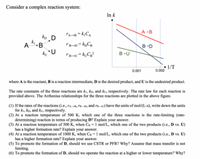
Introduction to Chemical Engineering Thermodynamics
8th Edition
ISBN: 9781259696527
Author: J.M. Smith Termodinamica en ingenieria quimica, Hendrick C Van Ness, Michael Abbott, Mark Swihart
Publisher: McGraw-Hill Education
expand_more
expand_more
format_list_bulleted
Question
i need help with last 3 parts of this question (4),(5) and (6) asap

Transcribed Image Text:Consider a complex reaction system:
In k
A -B
rA¬B = k,C^
kp D
A *1•B
ky * U
ľB¬D = kpCg
B•D
B-U
• 1/T
0.002
0.001
where A is the reactant, B is a reaction intermediate, D is the desired product, and U is the undesired product.
The rate constants of the three reactions are kı, kD, and ku, respectively. The rate law for each reaction is
provided above. The Arrhenius relationships for the three reactions are plotted in the above figure.
(1) If the rates of the reactions (i.e., ra¬B, rB–D, and r3-u) have the units of mol/(L-s), write down the units
for kı, kp, and ku, respectively.
(2) At a reaction temperature of 500 K, which one of the three reactions is the rate-limiting (rate-
determining) reaction in terms of producing D? Explain your answer.
(3) At a reaction temperature of 500 K, when Cg = 1 mol/L, which one of the two products (i.e., D vs. U)
has a higher formation rate? Explain your answer.
(4) At a reaction temperature of 1000 K, when Cg = 1 mol/L, which one of the two products (i.e., D vs. U)
has a higher formation rate? Explain your answer.
(5) To promote the formation of D, should we use CSTR or PFR? Why? Assume that mass transfer is not
limiting.
(6) To promote the formation of D, should we operate the reaction at a higher or lower temperature? Why?
Expert Solution
This question has been solved!
Explore an expertly crafted, step-by-step solution for a thorough understanding of key concepts.
Step by stepSolved in 2 steps with 1 images

Knowledge Booster
Similar questions
- Why is it important to indicate the wavelength of light used in your experimental data and on the Beer's Law plot?arrow_forwardWhat can be said about the three distillate (s) and bottoms products that would be produced in any column that is designed and operated as shown?arrow_forwardin packed towers experiment, The Ergun equation is a fine starting point for typical use in helping size/design columns in a variety of applications, however it makes numerous assumptions and approximations in its derivation. Can you name and explain (why) 2 regimes of operation where you clearly think the Ergun equation (at least the one we use in this class) would not be appropriate to use in column design?arrow_forward
Recommended textbooks for you
 Introduction to Chemical Engineering Thermodynami...Chemical EngineeringISBN:9781259696527Author:J.M. Smith Termodinamica en ingenieria quimica, Hendrick C Van Ness, Michael Abbott, Mark SwihartPublisher:McGraw-Hill Education
Introduction to Chemical Engineering Thermodynami...Chemical EngineeringISBN:9781259696527Author:J.M. Smith Termodinamica en ingenieria quimica, Hendrick C Van Ness, Michael Abbott, Mark SwihartPublisher:McGraw-Hill Education Elementary Principles of Chemical Processes, Bind...Chemical EngineeringISBN:9781118431221Author:Richard M. Felder, Ronald W. Rousseau, Lisa G. BullardPublisher:WILEY
Elementary Principles of Chemical Processes, Bind...Chemical EngineeringISBN:9781118431221Author:Richard M. Felder, Ronald W. Rousseau, Lisa G. BullardPublisher:WILEY Elements of Chemical Reaction Engineering (5th Ed...Chemical EngineeringISBN:9780133887518Author:H. Scott FoglerPublisher:Prentice Hall
Elements of Chemical Reaction Engineering (5th Ed...Chemical EngineeringISBN:9780133887518Author:H. Scott FoglerPublisher:Prentice Hall
 Industrial Plastics: Theory and ApplicationsChemical EngineeringISBN:9781285061238Author:Lokensgard, ErikPublisher:Delmar Cengage Learning
Industrial Plastics: Theory and ApplicationsChemical EngineeringISBN:9781285061238Author:Lokensgard, ErikPublisher:Delmar Cengage Learning Unit Operations of Chemical EngineeringChemical EngineeringISBN:9780072848236Author:Warren McCabe, Julian C. Smith, Peter HarriottPublisher:McGraw-Hill Companies, The
Unit Operations of Chemical EngineeringChemical EngineeringISBN:9780072848236Author:Warren McCabe, Julian C. Smith, Peter HarriottPublisher:McGraw-Hill Companies, The

Introduction to Chemical Engineering Thermodynami...
Chemical Engineering
ISBN:9781259696527
Author:J.M. Smith Termodinamica en ingenieria quimica, Hendrick C Van Ness, Michael Abbott, Mark Swihart
Publisher:McGraw-Hill Education

Elementary Principles of Chemical Processes, Bind...
Chemical Engineering
ISBN:9781118431221
Author:Richard M. Felder, Ronald W. Rousseau, Lisa G. Bullard
Publisher:WILEY

Elements of Chemical Reaction Engineering (5th Ed...
Chemical Engineering
ISBN:9780133887518
Author:H. Scott Fogler
Publisher:Prentice Hall


Industrial Plastics: Theory and Applications
Chemical Engineering
ISBN:9781285061238
Author:Lokensgard, Erik
Publisher:Delmar Cengage Learning

Unit Operations of Chemical Engineering
Chemical Engineering
ISBN:9780072848236
Author:Warren McCabe, Julian C. Smith, Peter Harriott
Publisher:McGraw-Hill Companies, The